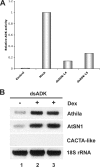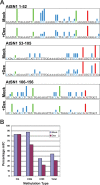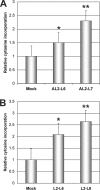Geminivirus AL2 and L2 proteins suppress transcriptional gene silencing and cause genome-wide reductions in cytosine methylation
- PMID: 19279102
- PMCID: PMC2682068
- DOI: 10.1128/JVI.01771-08
Geminivirus AL2 and L2 proteins suppress transcriptional gene silencing and cause genome-wide reductions in cytosine methylation
Abstract
Geminiviruses replicate single-stranded DNA genomes through double-stranded intermediates that associate with cellular histone proteins. Unlike RNA viruses, they are subject to RNA-directed methylation pathways that target viral chromatin and likely lead to transcriptional gene silencing (TGS). Here we present evidence that the related geminivirus proteins AL2 and L2 are able to suppress this aspect of host defense. AL2 and L2 interact with and inactivate adenosine kinase (ADK), which is required for efficient production of S-adenosyl methionine, an essential methyltransferase cofactor. We demonstrate that the viral proteins can reverse TGS of a green fluorescent protein (GFP) transgene in Nicotiana benthamiana when overexpressed from a Potato virus X vector and that reversal of TGS by geminiviruses requires L2 function. We also show that AL2 and L2 cause ectopic expression of endogenous Arabidopsis thaliana loci silenced by methylation in a manner that correlates with ADK inhibition. However, at one exceptional locus, ADK inhibition was insufficient and TGS reversal required the transcriptional activation domain of AL2. Using restriction-sensitive PCR and bisulfite sequencing, we showed that AL2-mediated TGS suppression is accompanied by reduced cytosine methylation. Finally, using a methylation-sensitive single-nucleotide extension assay, we showed that transgenic expression of AL2 or L2 causes global reduction in cytosine methylation. Our results provide further evidence that viral chromatin methylation is an important host defense and allow us to propose that as a countermeasure, geminivirus proteins reverse TGS by nonspecifically inhibiting cellular transmethylation reactions. To our knowledge, this is the first report that viral proteins can inhibit TGS.
Figures






References
-
- Aoyama, T., and N.-H. Chua. 1997. A glucocorticoid-mediated transcriptional induction system in transgenic plants. Plant J. 11605-612. - PubMed
-
- Bender, J. 2004. DNA methylation and epigenetics. Annu. Rev. Plant Biol. 5541-68. - PubMed
-
- Bent, A. 2006. Arabidopsis thaliana floral dip transformation method. Methods Mol. Biol. 34387-103. - PubMed
-
- Bisaro, D. M. 2006. Silencing suppression by geminivirus proteins. Virology 344158-168. - PubMed
Publication types
MeSH terms
Substances
LinkOut - more resources
Full Text Sources
Molecular Biology Databases
Miscellaneous

